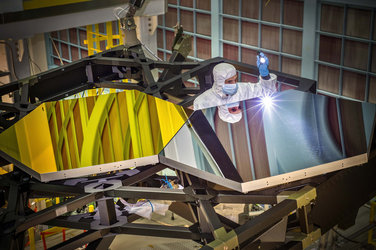MIRI factsheet
Overview of MIRI, the Mid-InfraRed Instrument, which is one of Europe's contributions to the James Webb Space Telescope.
Name
MIRI stands for Mid-InfraRed Instrument.
Status
The MIRI optical system was the first of the four Webb instruments delivered to NASA. The handover to NASA took place in May 2012. Since then it has been integrated into the payload module called the Integrated Science Instrument Module (ISIM).
Partnership
MIRI is part of Europe’s contribution to the James Webb Space Telescope (Webb) mission. It is a partnership between Europe and the USA; the main partners are ESA, a consortium of nationally funded European institutes, the Jet Propulsion Laboratory (JPL) and NASA's Goddard Space Flight Center (GSFC).
Description
MIRI is part of the instrument suite of the James Webb Space Telescope. Out of the four instruments, MIRI is the only one covering the mid-infrared wavelength range from 5 to 28.3 microns. It is an extremely versatile instrument, which will support all four of Webb’s science themes. It will open the door to new and exciting research and will be fundamental for a better understanding of the dawn of the formation of stars and galaxies. MIRI will produce mid-infrared images and spectra with an unprecedented combination of sharpness and sensitivity. It includes a coronographic mode, in which masks are placed in front of bright objects allowing scientists to study their immediate surroundings without being blinded by the light from the object itself.
Size and weight
The optical system of MIRI has a size of approximately 1.2 m x 1.2 m x 1.0 m and weighs less than 115 kg. It is combined with a unique cooling system that will cool down the optical bench to its very low operating temperature of approximately -266°C, more than 30 degrees cooler than the rest of the observatory.


Access the video
MIRI facts
MIRI will be the only mid-infrared instrument in Webb’s instrument suite and thanks to state-of-the-art instrument design and components, it will deliver mid-infrared images and spectra with an unprecedented combination of sharpness and sensitivity.
The MIRI optical system was designed, built and tested by consortium of nationally funded European institutes. The NASA Jet Propulsion Laboratory (JPL) supplied its detector system.
To ensure the signal from faint objects isn’t drowned out by the instrument’s own infrared glow, MIRI will be cooled down to close to -266°C, more than 30 degrees cooler than the rest of JWST observatory. This is made possible by a unique cryogenic cooling system constructed in the United States by Northrop Grumman Aerospace Systems (NGAS) under contract to NASA Jet Propulsion Laboratory (JPL).
MIRI will be capable of penetrating thick layers of dust obscuring regions of intense star birth. It will see the first generations of galaxies to form after the Big Bang, and it will study sites of new planet formation and the composition of the interstellar medium. It will also observe the light emitted, reflected or transmitted by exoplanets, the planets orbiting stars other than our Sun.














 Germany
Germany
 Austria
Austria
 Belgium
Belgium
 Denmark
Denmark
 Spain
Spain
 Estonia
Estonia
 Finland
Finland
 France
France
 Greece
Greece
 Hungary
Hungary
 Ireland
Ireland
 Italy
Italy
 Luxembourg
Luxembourg
 Norway
Norway
 The Netherlands
The Netherlands
 Poland
Poland
 Portugal
Portugal
 Czechia
Czechia
 Romania
Romania
 United Kingdom
United Kingdom
 Slovenia
Slovenia
 Sweden
Sweden
 Switzerland
Switzerland
































